Method for identifying planar array deconvolution sound source
A sound source identification and planar array technology, applied in the field of sound field identification, can solve problems such as difficult determination, deterioration of recognition accuracy, positioning deviation, etc., and achieve high spatial resolution and excellent overall performance
- Summary
- Abstract
- Description
- Claims
- Application Information
AI Technical Summary
Problems solved by technology
Method used
Image
Examples
Embodiment Construction
[0034] Below in conjunction with accompanying drawing and embodiment the present invention will be further described:
[0035] The present invention comprises the following steps:
[0036] Step 1. Compute traditional beamforming output
[0037] Microphone planar array sampling model such as figure 1 As shown in Fig. 1, it is assumed that the sound sources to be measured fall on the known sound source plane, the microphone plane array is located directly in front of the sound source plane, and the sound pressure signal received by the microphone is transformed into a full frequency domain The cross-spectrum matrix C is expressed by the following formula:
[0038] C=∑ r′ C(r')=∑ r′ q(r')v * (r')v T (r') (1)
[0039] In formula (1), r' is the sound source position vector, q(r') is the source intensity at r', superscript T and * denote transpose and conjugate respectively; v=[v m (r)] represents the steering column vector with the focal point r, v m (r) represents the ste...
PUM
 Login to View More
Login to View More Abstract
Description
Claims
Application Information
 Login to View More
Login to View More - R&D
- Intellectual Property
- Life Sciences
- Materials
- Tech Scout
- Unparalleled Data Quality
- Higher Quality Content
- 60% Fewer Hallucinations
Browse by: Latest US Patents, China's latest patents, Technical Efficacy Thesaurus, Application Domain, Technology Topic, Popular Technical Reports.
© 2025 PatSnap. All rights reserved.Legal|Privacy policy|Modern Slavery Act Transparency Statement|Sitemap|About US| Contact US: help@patsnap.com



